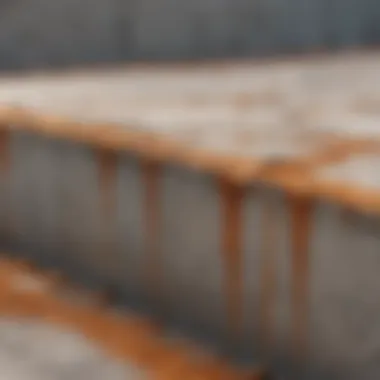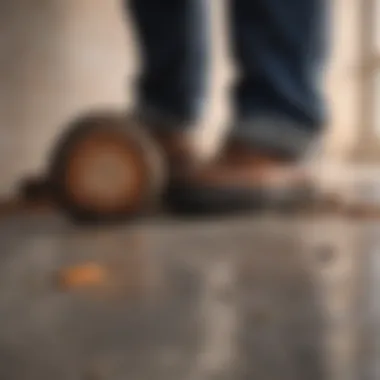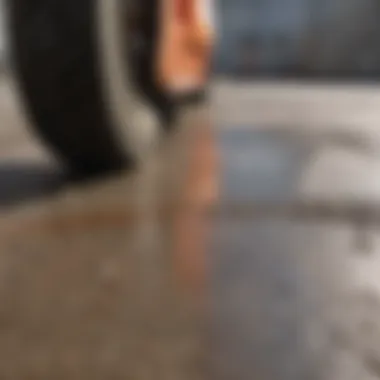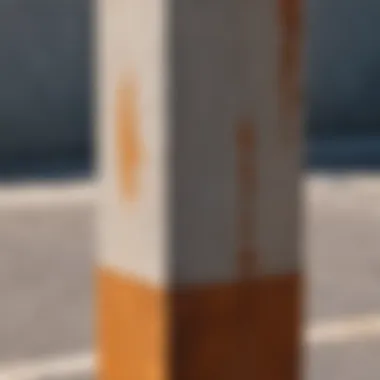Effective Methods to Clean Rust Off Concrete Surfaces


Intro
Rust stains on concrete surfaces can be an eyesore for homeowners and maintenance professionals alike. They often occur due to metal objects in contact with concrete or through outdoor interactions with rain and humidity. Understanding how these stains form is crucial for effective cleaning.
Concrete, as a porous material, can absorb moisture. When metal rusts, it can leave behind reddish-brown discolorations that mar the otherwise uniform appearance of the concrete. Furthermore, these stains can be hazardous, making walkways slippery and unattractive. Thankfully, there are various techniques and methods to restore the concrete back to its original state.
This article aims to equip you with actionable knowledge about rust removal from concrete. We will explore effective cleaning methods, including household items and commercial rust removers. Also, we will highlight safety precautions and eco-friendly practices that should be observed during the cleaning process. Lastly, maintaining your concrete surfaces post-cleaning will be addressed to prevent future discoloration.
By the end of this article, you will have a thorough understanding of how to tackle rust stains efficiently and preserve the integrity of your concrete surfaces.
Understanding Rust Stains on Concrete
Understanding rust stains on concrete is crucial for homeowners and maintenance professionals alike. These stains not only detract from the visual appeal of surfaces but can also indicate underlying issues related to the concrete's integrity. Identifying the cause of these stains can lead to more effective cleaning methods and long-term solutions. Moreover, knowing how to properly deal with rust stains can preserve the structural integrity of concrete, which is essential for patios, walkways, and driveways.
What Causes Rust on Concrete
Rust on concrete typically arises due to the presence of metallic iron, which oxidizes when exposed to moisture and oxygen. This oxidation forms iron oxide, commonly recognized as rust. If rebar or other steel supports are embedded in concrete and become exposed to the elements, they can initiate rust formation.
Environmental factors also play a significant role in rust development. Locations that experience high humidity or have frequent rainfall are particularly susceptible to rust stains. Additionally, the usage of de-icing salts in wintertime can exacerbate these conditions, as the salts can penetrate the concrete and contribute to rust formation.
Common Sources of Rust Stains
Identifying common sources of rust stains can aid in prevention and remediation. Some frequent sources include:
- Metal furniture and tools: Items made from iron or steel may leak rust onto concrete surfaces when they come into contact with moisture.
- Plant containers: Metal pots or planters can corrode and create stains if they sit directly on the concrete surface.
- Industrial materials: Concrete that comes in contact with construction materials or equipment can suffer from rust stains.
- Water runoff: Water carrying rust particles from metal surfaces can lead to staining in areas close to the runoff path.
By being aware of these sources, it becomes easier to take preventative measures. Taking steps to mitigate rust formation will lead to a cleaner, more aesthetically pleasing concrete surface over time.
Assessing the Severity of Rust Stains
Understanding the severity of rust stains on concrete is a crucial step before taking on any cleaning task. It not only informs you about the appropriate removal method but also affects the overall health and appearance of the concrete surface. Ignoring the extent of the staining can lead to ineffective cleaning efforts and potential damage. Assessing the severity enables homeowners to choose techniques that suit the specific conditions of their surfaces and to be aware of any signs of deeper issues.
Identifying Different Types of Stains
Rust stains on concrete can vary significantly in appearance and cause. Typically, these stains appear as reddish-orange marks. They can range from slight discoloration to heavy, entrenched stains. In general, understanding what type of stain you have can guide your cleaning strategy.
- Surface Stains: These stains are new and often caused by exposure to metal items or equipment. Simple cleaning methods may be effective for these.
- Older, Deeper Stains: These are often a result of prolonged exposure and may require more intensive cleaning approaches or products.
- Underlying Concrete Issues: Sometimes stains hint at bigger problems, such as moisture or structural defects that need addressing. Identifying these early can save extensive costs down the line.
Determining the Impact on Concrete Longevity
Rust stains do not simply affect aesthetics; they can also have lasting implications on the structure and integrity of concrete. When assessing the impact on longevity, consider the following aspects:
- Surface Integrity: Rust can signify the presence of moisture that may degrade the concrete over time, leading to cracks or flaking.
- Structural Concerns: If the rust stems from rebar or other internal metal supports, it may compromise the overall strength of the concrete.
- Need for Professional Inspection: In cases where rust is severe or persisting after initial cleaning efforts, consulting a professional should be prioritized. They can assess damage more thoroughly and provide solutions that preserve your concrete's lifespan.
By addressing rust stains promptly and assessing their severity, homeowners can maintain the aesthetic appeal and structural integrity of their concrete surfaces.
Preparation Before Cleaning
Cleaning rust stains from concrete is not solely about applying cleaning agents and scrubbing the surface. Preparation is a critical step that sets the foundation for successful rust removal. Without adequate preparation, the cleaning process can become ineffective, leading to wasted time and effort. When properly prepared, one can ensure that the right techniques and tools are utilized effectively, enhancing the results of the cleaning.
The importance of preparation can be seen in a few specific areas. First, the right tools and materials can significantly improve the efficiency of the cleaning process. Having these items ready allows you to quickly address the problem without delays. Second, understanding safety precautions minimizes risks associated with using chemicals or performing physical labor. Finally, assessing the extent of the rust stains before cleaning can inform you about the most suitable methods and products to use.
Gathering Necessary Tools and Materials
When addressing rust stains on concrete, it is essential to gather all necessary tools and materials beforehand. This prevents interruptions during the cleaning process and helps ensure that you can maintain a focused effort. Here’s a list of common items you may need:
- Stiff-bristled brush: Useful for scrubbing away rust and debris.
- Buckets: Needed for mixing cleaning solutions or rinsing tools.
- Cleaning agents: This can include household items like baking soda, white vinegar, or commercial rust removers tailored for concrete.
- Protective gear: Such as gloves and safety goggles, to protect skin and eyes from harsh chemicals.
- Pressure washer (if applicable): Effectively removes stubborn stains and is useful for larger areas.
By having these items readily available, the cleaning process can proceed without unnecessary delays. An organized approach to gathering tools will streamline your rust removal experience.
Safety Precautions to Consider
Safety should always be a priority when cleaning rust off concrete. The chemicals involved, even those from natural sources, can pose risks if handled incorrectly. Here are some crucial safety precautions to keep in mind:


- Wear Protective Gear: Always wear gloves and goggles when handling any cleaning solutions, especially chemical products. This protects against irritation or injury.
- Work in a Well-Ventilated Area: Ensure adequate airflow if using strong commercial cleaners, as fumes can be harmful when inhaled.
- Avoid Mixing Chemicals: Different cleaning agents can react dangerously when mixed. Stick to one type of cleaner at a time.
- Read Instructions Carefully: Each product has specific guidelines. Overlooking these can lead to poor results or safety hazards.
By adhering to these safety measures, you enhance your ability to clean effectively while minimizing potential risks. The right preparation can transform a labor-intensive task into a manageable and successful endeavor.
Proper preparation is half the battle won in cleaning rust stains effectively. Prioritizing safety and organization leads to better results.
Cleaning Methods for Rust Removal
Cleaning rust off concrete requires a variety of methods, each suited to different types of stains and severity. The right technique can greatly enhance the effectiveness of the cleanup effort and preserve the integrity of the concrete surface. As rust stains can diminish the aesthetic appeal and even the functionality of concrete, finding effective cleaning methods is crucial. This section explores multiple approaches, their benefits, and important considerations related to the rust removal process.
Using Household Items
Household items often provide cost-effective solutions to rust stains. Three common products stand out in this regard:
Baking Soda and Water Paste
Baking soda works well as a mild abrasive and a pH neutralizer. When combined with water, it forms a paste ideal for scrubbing on stained surfaces. Its mildness ensures it does not harm the concrete, making it a safe and effective choice.
Key characteristics of this method include:
- Natural Cleaner: Baking soda is non-toxic and safe to use around pets and plants.
- Abrasive Quality: It offers sufficient scrubbing power to break down rust without scratching the concrete.
A drawback is that it might require more elbow grease for tougher stains. It is best used for light rust accumulations.
White Vinegar Application
White vinegar is effective for rust removal due to its acetic acid content, which reacts with rust. Applying it directly to the rust stains can dissolve them quickly. This method is particularly useful on small or localized stains.
The main benefits include:
- Easy to Obtain: Most households already have white vinegar, adding convenience to the cleaning process.
- Environmentally Friendly: It is a non-toxic option compared to harsher chemicals.
However, using vinegar might not yield significant results on larger or deeper rust stains. It is better for routine maintenance or immediate, minor stain treatment.
Lemon Juice for Mild Stains
Lemon juice, similar to vinegar, contains citric acid, which can effectively lift mild rust stains. It offers a pleasant smell, contrasting with other chemical solutions.
Benefits of using lemon juice:
- Gentle on Surfaces: It is a safe option for various materials, including concrete.
- Fresh Scent: Unlike some cleaners, lemon juice can improve the smell of your surroundings.
Its limitation lies in effectiveness, as it is most suitable for mild stains only. For heavy rust, it may not provide satisfactory results, and repeated applications might be necessary.
Commercial Rust Removers
For more stubborn rust stains, commercial rust removers offer powerful cleaning options. Selecting the right product is crucial for both effectiveness and concrete safety.
Choosing the Right Product
When opting for commercial rust removers, consider the stain's severity and the product's chemical composition. Different brands may utilize various active ingredients, from phosphoric acid to oxalic acid.
Key points:
- Effectiveness: Products formulated for rust removal often include strong ingredients that can tackle even the toughest stains.
- Versatility: Many of these products can work on various surfaces, not just concrete.
Be mindful that strong chemicals can potentially damage surrounding vegetation or other surfaces if not used carefully.
Application Techniques
Proper application of rust removers is vital for achieving optimal results. Techniques vary, and often they involve applying the product, allowing it to sit, and then scrubbing the area.
Key observations include:


- Follow Instructions: Each product will have specific recommendations for application. Skipping steps can lead to poor results.
- Scrubbing Action: Many removers require some manual effort to reach the best results, depending on the stain's stubbornness.
Incorrect application can result in incomplete rust removal or damage to the concrete finish.
Effectiveness Comparison
When contemplating rust removal, comparing various products is vital. Readily available reviews may provide insights into product effectiveness, application ease, and cost.
Highlights include:
- User Feedback: Assessing ratings from other consumers can guide the decision-making process.
- Cost Efficiency: Comparing price points concerning the results provided can lead to better choices, saving money in the long run.
Considering these aspects helps homeowners select rust removers that meet their specific needs.
Pressure Washing as a Solution
Pressure washing is another option for removing rust stains, particularly for extensive surfaces. The method involves using high-pressure water jets to dislodge rust and dirt particles that adhere to the concrete.
Important points include:
- Deep Cleaning: The high pressure can effectively clean large areas quickly, making it suitable for driveways or patios.
- Less Manual Labor: Compared to scrubbing, a pressure washer can require less physical effort than other methods.
However, caution is required as excessive pressure can lead to damage. Setting the right pressure level and angle while washing is crucial to protect the concrete surface while ensuring effective cleaning.
Post-Cleaning Care
Post-cleaning care is a vital step in the process of restoring concrete surfaces after rust removal. It ensures that the cleaning efforts yield long-lasting results and protects the integrity of the concrete over time. Proper care prevents the recurrence of rust stains and maintains the aesthetic appeal of the surface. Failing to engage in post-cleaning care can lead to a quick return of stains, undermining all previous work.
The focus here is on two main actions: inspecting the cleaned area and sealing the concrete. Both these steps contribute to maintaining a clean surface, enhancing durability, and optimizing the investment made in cleaning.
Inspecting the Cleaned Area
Once rust stains are removed, it's essential to conduct a thorough inspection of the cleaned area. This inspection serves multiple purposes. It allows you to ensure that no rust stains remain and that the cleaning process has been effective. Moving your hand over the surface can help feel for any uneven textures or residues that may have been missed during cleaning.
When inspecting, look for:
- Stains: Examine if any remnants of rust are present. Sometimes, initial cleaning may not fully eliminate all discoloration.
- Surface Integrity: Check for cracks or spalling that could compromise the concrete's longevity.
- Moisture Retention: If the surface feels damp, it could indicate inadequate drying or sealant application.
This inspection plays a crucial role in understanding the condition of your concrete and planning any further action if needed.
Sealing Concrete to Prevent Future Stains
Sealing the concrete surface is one of the most effective methods to prevent future rust stains. A quality sealant forms a protective layer over the concrete, blocking moisture and contaminants from penetrating. This action minimizes the risk of rust formation and extends the lifespan of the concrete.
When choosing a sealant, consider the following factors:
- Type of Sealant: Opt for penetrating sealers that bond with the concrete, as they tend to provide better protection.
- Application Method: Follow the manufacturer’s instructions carefully for the best results; some may require a sprayer, while others can be applied with a roller.
- Reapplication Frequency: Sealants wear off over time, and regular reapplication is necessary for ongoing protection. Check the product guidelines for specific timelines.
Applying sealant after cleaning not only protects against future rust stains but also enhances the aesthetic of the concrete, resulting in a clean and polished appearance.
In summary, effective post-cleaning care is a crucial part of maintaining the cleanliness and longevity of concrete surfaces. Through diligent inspection, one ensures the cleaning was successful, and sealing the concrete stands as a barrier against future stains. Investing time in these tasks enriches the overall upkeep of concrete, safeguarding it for years to come.
Preventing Rust Stains on Concrete
Preventing rust stains on concrete surfaces is a vital aspect of maintaining both the aesthetic appeal and structural integrity of these surfaces. By proactively addressing potential rust issues, homeowners can save significant time and effort in the long run. Understanding the underlying factors that contribute to rust formation helps in implementing effective preventative measures. Rust is not merely an eyesore but also an indication of deeper issues that, if left unchecked, can compromise concrete's durability.
Regular Maintenance Practices
Implementing regular maintenance practices is crucial in keeping rust stains at bay. One critical method is conducting routine inspections of the concrete surfaces. Look for signs of wear, moisture accumulation, or any visible rust. Addressing small problems early can prevent larger issues from developing.
Additionally, ensuring proper drainage around your concrete structures is important. Water pooling can lead to increased rust formation, especially if there are metallic components present. Keeping gutters and downspouts clear reduces excess water runoff.
For cleaning, establish a schedule that includes gentle pressure washing every few months. This not only removes dirt and debris but also keeps rust at minimum by not allowing contaminants to settle. Using a mixture of mild detergents with water during these cleanings can enhance effectiveness. Furthermore, consider applying a specialized concrete sealer. This provides an extra level of protection against rust by creating an impermeable barrier, which can drastically reduce the chances of water infiltration.


Choosing Appropriate Landscaping Materials
The landscaping materials you choose can have a significant impact on the likelihood of rust stains on your concrete. When selecting materials such as garden furniture, planters, or metal decorations, opt for rust-resistant options. Stainless steel or aluminum products are wise choices since they do not corrode easily.
Additionally, avoid using fertilizers or gardening supplies that contain high levels of iron near concrete surfaces. Spills or runoff from these materials can lead to unpleasant rust stains. Instead, consider environmentally friendlier landscaping options that are less likely to interact negatively with your concrete.
Regular maintenance of landscaping is also key. Trim back any plant growth that may retain moisture against concrete surfaces. Furthermore, ensure any metal fixtures are in good condition and that they do not deteriorate into rust.
Preventing rust stains is always more efficient than trying to clean them off later. Investing in good materials and routine care pays off.
By implementing these simple yet effective methods of prevention, homeowners can contribute significantly to the longevity of their concrete and avoid the headache of rust stains.
Addressing Environmental Concerns
Eco-Friendly Cleaning Solutions
Eco-friendly cleaning solutions serve as the foundation for maintaining a clean environment while tackling issues like rust stains on concrete. These solutions often comprise natural ingredients that minimize health risks associated with harsh chemicals.
- Vinegar: A common household item, vinegar can effectively dissolve rust while being non-toxic. Its acidic nature breaks down rust particles without releasing harmful fumes.
- Baking Soda: Another staple, baking soda works well as a mild abrasive and can be combined with water to create a paste for scrubbing.
- Lemon Juice: The natural acidity in lemon juice can effectively remove light rust stains, and it leaves a fresh scent behind.
These solutions not only clean but also reduce the user’s carbon footprint, aligning everyday practices with environmental sustainability.
Impact of Harsh Chemicals on Surroundings
The use of harsh chemicals in cleaning products can have detrimental effects on the environment. These compounds often leach into the soil and waterways, posing risks to plant and animal ecosystems. Some aspects include:
- Water Contamination: When chemicals wash away, they can enter streams, lakes, and rivers, disrupting aquatic life and water quality.
- Soil Degradation: Chemicals can alter soil composition, harming beneficial microorganisms necessary for plant health.
- Air Quality: Many commercial rust removers emit volatile organic compounds (VOCs) that can irritate respiratory systems and contribute to air pollution.
When to Consult Professionals
Rust stains on concrete can range from mild discoloration to severe damage. As a homeowner or maintenance professional, understanding when to seek expert assistance is vital. This choice safeguards the integrity of the surface and ensures effective treatment. Factors like stain severity, the concrete's overall condition, and the presence of underlying issues should inform your decision. Consulting with experts can save time, money, and ensure the right methods are applied for rust removal.
It's important to remember that attempting to tackle severe rust stains without proper expertise may lead to more damage, costing you considerably more in the long run.
Identifying Complex Cases
Some rust stains are simple to treat. However, others can be complex, requiring professional insight. Situations such as extensive rust penetration or widespread staining often signify deeper issues. Inspecting the concrete for cracks or structural flaws is crucial. If rust seems to originate from embedded metal, like rebar, or if the stains are recurring despite cleaning, professional help is justified.
Consider the size of the affected area. Small patches might be manageable with DIY methods, but larger stains can indicate a more significant issue. If you notice additional deterioration, like spalling or crumbling, it reflects a need for professional evaluation. An expert has access to advanced tools and techniques, ensuring the stain is treated effectively and with lasting results.
Evaluating Cost vs. DIY Options
Before deciding to employ professionals, evaluate the cost implications versus DIY methods. On the surface, do-it-yourself cleaning solutions may appear more economical. Products like baking soda or white vinegar are readily available and inexpensive. However, consider the time investment and effectiveness of these methods for significant stains.
If the rust is persistent, you may need specialized products or equipment that come at a higher initial cost. Professional services can be more expenseive upfront, but they often guarantee thorough removal and may prevent future staining.
When assessing cost:
- Consider time commitment: DIY may take longer and require multiple attempts.
- Factor in potential damage: Inexperience can lead to further damage, raising repair costs.
- Check for guarantees: Professionals often offer service guarantees that provide additional peace of mind.
End and Key Takeaways
Cleaning rust off concrete is essential for maintaining the appearance and longevity of your surfaces. The methods outlined in this article offer effective ways to address rust stains, ensuring that your concrete looks its best. By summarizing effective techniques, we can reinforce the concept that cleaning is not a one-time effort but rather an ongoing process. Regular attention helps prevent the recurrence of stains. Understanding which methods to use and when can save time and money for homeowners and maintenance professionals alike.
Summarizing Effective Techniques
Several techniques for removing rust stains have been discussed in detail, including household items like baking soda and vinegar, as well as commercial rust removers. Here’s a quick recap of the methods:
- Household Items: Baking soda, white vinegar, and lemon juice are accessible options that often yield good results without harsh chemicals. These are suitable for small or mild stains.
- Commercial Products: For more stubborn stains, consider using products designed specifically for rust removal. It is important to read labels to find suitable options that align with your cleaning needs.
- Pressure Washing: A powerful method for removing rust from larger areas, but caution is needed to avoid damaging the concrete.
Each method has its own strengths, depending on the severity of the rust and the area it covers. Evaluating the best option helps in achieving the desired results effectively.
Encouraging Regular Maintenance
Routine maintenance can prevent rust stains from forming in the first place. Here are a few overall practices to consider:
- Regular Cleaning: Regular sweeping and washing can prevent dirt and moisture buildup that may lead to rust.
- Sealing Concrete: Applying a sealant can protect the surface from rust-causing agents.
- Timely Repairs: Addressing cracks or mortar issues helps to limit water intrusion and oxidation that leads to rust.
Maintaining concrete surfaces is a task that can greatly benefit from consistency. Regular checks and early interventions aid in extending the life of the concrete while keeping it visually appealing. Effective cleaning techniques coupled with scheduling maintenance intervals will yield significant benefits in terms of aesthetics and durability.
Taking proactive steps towards cleaning and maintenance ensures that your concrete remains pristine and functional without unexpected costs down the line.







